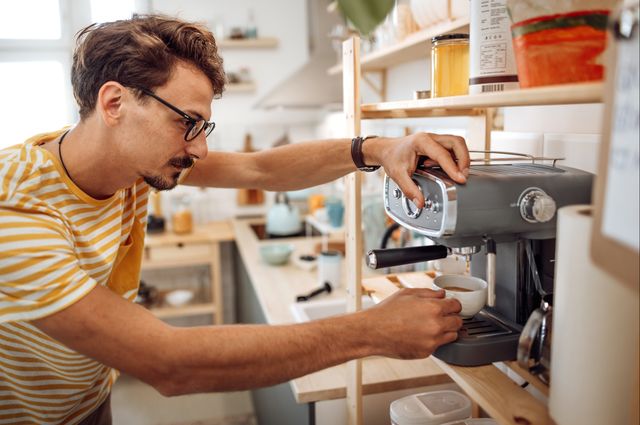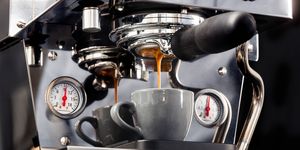If you're a fan of espresso and drink it every day, you've probably considered purchasing a home espresso machine. That's because buying espresso drinks at your neighborhood cafe adds up quickly — very quickly.
Square and the Specialty Coffee Association teamed up for a large-scale study on the state of the coffee business in 2018, and they found that the average price of a latte in the US — the nation's most popular coffee drink order, taking the top spot in all but six states — was $4.16. If you're spending that every day, then you're looking at around $125 a month.
On the other hand, home espresso machines aren't exactly cheap. If you're looking for a barista-level machine where you can pull your own shots and master your latte art, then you're going to be looking at several thousand-dollar options from brands like La Marzocco, whose cheapest machine, the Linea Micra, retails for $3,900.
Those types of machines are pretty niche, so if you're like most people and just want a solid home espresso machine that allows you to make most drinks without any expert training, then you may end up with one of Breville's many lauded options.
For the sake of this article, let's say you choose the Breville Barista Touch, which sits in the middle of the brand's lineup and is a great option for both novices and baristas alike. It also sits at an interesting price point — $999.95 — which is serious enough to merit some careful calculations, but not so outrageous as to seem insane for most people. OK, so now that we've got our machine, it's time to do some math, so bust out those calculators.
We're going to assume you'll be making a latte every day, since that's most people's go-to order. But since the data we're using is from 2018, we'll need to update our average latte cost to account for inflation.
Using the Bureau of Labor Statistics' CPI Inflation Calculator, $4.16 in June 2018, the date the study ended, is equal to $5.08 in October 2023, the most recent month for which data is available. So, if you buy a latte at $5.08 every day for one year, then your annual latte spending comes out to $1,854.20.
But we're not done quite yet. According to Square's previously referenced study, the average tip on a cup of coffee in the US is 11.4%, which adds another $211.37 to our sum, bringing our total yearly latte spend to $2,065.57.
You may be looking at that number and thinking that you're already sitting pretty, able to pay off your new Breville well within a year of buying it. But not so fast. You've still got to pay for all of the espresso you'll be making in your new machine.
We'll split the difference between specialty roasters and Starbucks, assuming that your habits will fall somewhere in the middle. A 12-ounce bag of Elevate espresso beans from New York-based Partners Coffee Roasters is $18.50. For Starbucks, you can get a 12-ounce bag of their Espresso Roast beans for $9.99 at Target. So, adding those two together, you're spending $28.49 on 24 ounces of coffee.
Oh, we'll also need something to grind those beans. While our referenced espresso machine does include a built-in grinder, many on the market do not. So we're going to account for the cost of one just to make sure we're covering all of our bases. Our favorite grinder is the Baratza Encore, which retails for $149.95. So that will need to be factored into our total.
For each latte, let's say you're using a double shot, consisting of 19 grams of ground espresso — Breville's recommended amount for a latte. Twenty-four ounces is equivalent to 680.4 grams, meaning your two bags of coffee will make about 35.8 lattes. But lattes also require milk, making up 2/3 of each drink, plus some extra for the microfoam on top.
Your double espresso shot, once pulled, should be about two ounces of liquid espresso, meaning you'll need four ounces of steamed milk in your cup, plus another ounce or two for your foam. To make it easy, we'll say five ounces of milk will go into each latte. According to the USDA's Retail Milk Prices Report for November 2023, the average nationwide price for a gallon of whole milk is $4.36. One gallon contains 128 ounces, meaning a gallon of milk will make you 25.6 lattes.
Combining our coffee cost and milk cost, the average home price for the ingredients to make each latte comes out to $0.97 per latte.
Next, we need to figure out the energy cost of running our machine. Breville's Barista Touch uses 1,680 watts, and the average energy cost in the US is currently $0.1593 per kilowatt-hour, according to the US Government's Energy Information Administration. If we run the machine for five minutes a day, the daily energy cost to make up one latte comes to $0.0222. (The grinder runs for only a couple of seconds per day and uses just 70 watts, so we're considering its energy consumption negligible.) So, adding up our ingredient cost to our energy cost, we get a grand total of $0.99 per at-home latte — without accounting for the cost of our hardware.
So, where does that leave us? Well, our daily latte spend outside the home was $5.66 ($5.08 plus an 11.4% tip), meaning our at-home latte is about $4.67 cheaper to make — a significant savings. But, we've still got to factor in the $1,149.90 we dropped on the espresso machine and grinder. So, if we divide 1,149.90 by 4.67, we get 246.2, meaning it will take 247 days for your espresso machine to effectively pay for itself.
Of course, your particular situation will vary, but this should serve as food for thought when you're thinking of pulling the trigger on that pricey espresso machine you've been eyeing. If you want to plug in your own variables, here's the general formula for your use (and modification):
Cost of Equipment / Savings Per Cup ([Cafe Latte + Tip] - [Milk + Beans + Energy Use]) = Days for Machine to Pay For Itself
























